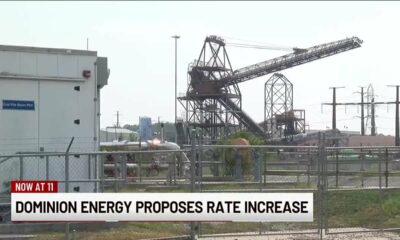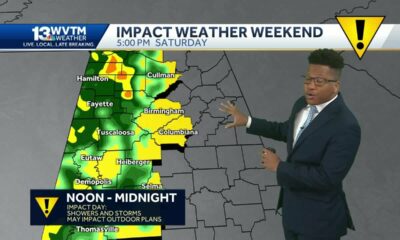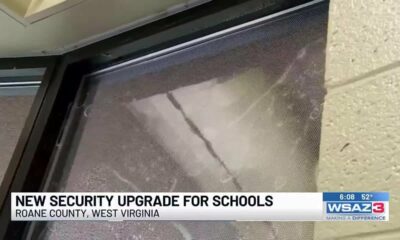News from the South - North Carolina News Feed
Lead detected in seven schools after Asheville water didn’t undergo mitigation process for several weeks • Asheville Watchdog
Lead has been detected in seven area schools after Asheville Water Resources suspended a standard treatment for lead mitigation for nearly three weeks because the city’s main reservoir’s sedimentation was so high.
Water and health officials made the announcement at the daily Helene briefing Thursday, stressing that the presence of lead, a toxic metal, came mostly because schools, and their pipes, sat idle for weeks. They also stressed that students have not been consuming lead because water fountains at the schools have been closed since students returned.
Water Resources spokesperson Clay Chandler said the department received the last of the lab results regarding lead Nov. 8. Chandler said schools and other facilities with detectable lead were notified of the findings within 24 hours of the city receiving results.
“Schools with detectable levels of lead in the county system are Oakley Elementary School, Sand Hill Elementary School, Charles C. Bell Elementary School and Glen Arden Elementary School,” Chandler said. “In the city system, those schools are Lucy Herring Elementary School and Hall Fletcher Elementary School. The private school, and the only one who participated, was Odyssey Community School.”
Lead’s toxicity led the EPA to set its acceptable level at zero in drinking water because it can cause developmental delays, and learning and behavior problems, especially in younger children.
Chandler and Dr. Jennifer Mullendore, medical director for Buncombe County’s Department of Health & Human Services, repeatedly stressed that students were not exposed to lead in drinking water.
“It is very important to note that the students have not consumed the tap water in any of these schools or child care facilities,” Chandler said. “Schools will keep water fountains closed off and unplugged, and EPA has provided schools guidance that includes the installation of National Sanitation Foundation certified filters that are designed specifically to remove lead or reduce lead.”
Mullendore said there have been no reports of students with lead in their bloodstream.
The testing results can be found on the city’s Water Resources “Helene Response and Recovery” page, under “Post-Helene Lead and Copper Sampling Plan and Results.”
Tropical Storm Helene slammed the region Sept. 27, knocking out the city’s water supply at North Fork Reservoir, which provides 80 percent of the city’s drinking water. The city restored non-potable water to nearly all of the system by mid-October, but stubborn turbidity, or murkiness, at North Fork, has prevented restoration of potable water, which is likely to return in early to mid-December.
Corrosion control suspended
Chandler and Brenna Cook, the compliance manager at Water Resources, said the city normally treats for lead with zinc orthophosphate and sodium bicarbonate, as these minerals coat the insides of pipes, with the zinc material absorbing the lead and keeping it from reacting with the water. The bicarbonate is added “for alkalinity purposes, so that if the pH should change, it buffers it to keep it from changing and slowing down the corrosion control process,” Cook said.
The city was unable to provide corrosion control for 19 days, Chandler said, noting that during that time the city was treating the water only with chlorine, a decontaminant. Chlorine can corrode pipes with lead in them, causing the metal to leach into the water.
The city initially was super-chlorinating the water from North Fork at 8 parts per million, but has dropped that level to 2.5 parts per million.
Asheville has been under a boil water notice since the outage, with residents being encouraged to use only bottled water for drinking or consumption, including cooking.

The other concern for lead getting into system users’ taps is homes or buildings built before 1988, when lead in pipes was banned. The city stressed that its distribution pipes do not contain lead, and it has no detectable lead in the reservoir.
“It’s mostly service lines that are vulnerable for that, or internal household plumbing,” Cook said, estimating that about 60 percent of the homes on the water system were built before 1988. She noted that some may have been remodeled, and pipes with lead in them removed, so that number could be lower.
The city’s testing contractor took water samples from 25 points throughout the distribution system from Oct. 17 through Oct. 24. All samples were taken from privately owned plumbing.
Buncombe County Schools Superintendent Rob Jackson and Asheville City Schools Superintendent Maggie Fehrman said children have been consuming only bottled water on site.
Students consuming only bottled water, schools say
“Prior to reopening, we worked with the water system to ensure that we had safe schools to open, and so we covered our water fountains before our students returned to the schools,” Jackson said. “And we will keep those covered until testing shows that the water is safe for consumption, however long that takes.”

Fehrman said most of the city’s elementary schools have pre-kindergarten classrooms, “so we actually have lead testing as a regular part of making sure that our water is safe for our pre-K students.
“So from time to time, we have had detectable levels identified at our schools, and we take mitigation efforts as those come up,” Fehrman said. “But we are pleased that the levels that we saw, especially after flushing, are below that level. And again, our water fountains are closed. We are not using any of that water at Hall Fletcher or Lucy Herring.”

Chandler and Cook said flushing the water lines is crucial.
“According to guidance from the EPA, this flushing protocol is a short-term solution that can be used to reduce potential lead and copper presence in drinking water,” Chandler said. “Depending on the pipe materials, lead and copper may be found in water that has sat undisturbed in household plumbing for four to six hours.”
The city’s testing found copper levels were all “well below allowable levels,” Chandler said.
Flushing is crucial, officials say
Chandler emphasized that flushing is especially important for plumbing installed before 1988. It was common practice to use lead solder to join pipes before then.
“Until more investigative lead and copper sampling is conducted that shows corrosion control treatment has taken effect, please continue to follow this simple flushing protocol daily,” Chandler said.
Users should run the water from the faucet for 30 seconds to two minutes, or when they feel the temperature of the water change (usually to a cooler temperature).
Chandler said the city will resample the water for lead at one, three and six months at the schools and at any private residences that had detectable lead levels.
“Water Resources encourages customers, especially those with homes built prior to 1988, to participate in the city’s free lead and copper drinking water testing program,” Chandler said. “And you can do that by emailing leadprevention@ashevillenc.gov, or by calling 828-259-5962.”
Mullendore said that while “no children or individuals at schools have been consuming the water, it is possible that individual homeowners might have been using water from their taps for drinking or for preparing food.”
“So we know that there are health risks from lead exposure, and we know that the most vulnerable populations are children under the age of six, pregnant people and breastfeeding people,” Mullendore said. “And the reason for that is that children under six are growing rapidly. So their bodies are growing rapidly. And we know that pregnant people are growing a fetus inside them, which is also growing rapidly. And then breastfeeding people are breastfeeding infants that are growing rapidly.”
Mullendore said if you have a child under age six who may have been exposed to lead by drinking water or eating food or beverages that were made with City of Asheville water, “we encourage you to talk with your child’s health care provider about getting blood lead testing for them.
“Same if you are a pregnant person or a breastfeeding person who, again, you have potentially been exposed to lead because you have been consuming the city’s water or using it for preparing food or beverage,” Mullendore said. “We encourage you to talk with your prenatal care provider, your primary care provider, about blood lead testing.”
Asheville Watchdog is a nonprofit news team producing stories that matter to Asheville and Buncombe County. John Boyle has been covering Asheville and surrounding communities since the 20th century. You can reach him at (828) 337-0941, or via email at jboyle@avlwatchdog.org. The Watchdog’s local reporting during this crisis is made possible by donations from the community. To show your support for this vital public service go to avlwatchdog.org/support-our-publication/.
Related
The post Lead detected in seven schools after Asheville water didn’t undergo mitigation process for several weeks • Asheville Watchdog appeared first on avlwatchdog.org
News from the South - North Carolina News Feed
Raleigh City Council discusses transforming area near Lenovo Center, hears concerns
SUMMARY: Raleigh City Council is considering a major redevelopment project near the Lenovo Center that would create a new sports and entertainment district with high-rise buildings, restaurants, shops, and upgraded arena facilities. The proposal, supported by city leaders and the Carolina Hurricanes—who agreed to stay for 20 more years—has drawn both excitement and concerns. Students and staff from nearby Cardinal Gibbons High School support the project but worry about pedestrian safety and construction impacts. City leaders suggested annual reviews to address ongoing issues. The council postponed rezoning decisions until April 15 to allow for more discussion and public input.

New details are emerging about the bold new development that could transform the area around Raleigh’s Lenovo Center, creating a new entertainment district around the arena in west Raleigh.
More: https://abc11.com/post/raleigh-city-council-will-discuss-future-including-wake-bus-rapid-transit-project-housing-security/16114907/
Download: https://abc11.com/apps/
Like us on Facebook: https://www.facebook.com/ABC11/
Threads: https://www.threads.net/@abc11_wtvd
X: https://x.com/ABC11_WTVD
Instagram: https://www.instagram.com/abc11_wtvd/
TIKTOK: https://www.tiktok.com/@abc11_eyewitnessnews
Subscribe: https://www.youtube.com/c/ABC11-WTVD
News from the South - North Carolina News Feed
Asheville has North Carolina’s worst unemployment rate, state says
Six months later and still out of a job. That’s the reality for nearly 13,000 Asheville residents half a year after Tropical Storm Helene struck Western North Carolina.
In the wake of the historic storm, hundreds of businesses closed. The region’s multibillion dollar tourism sector took a devastating hit. Thousands of people were severed from their jobs. Many have not returned to the workforce.
Asheville, a city of roughly 95,000 people, typically boasts the lowest unemployment rate of North Carolina’s municipalities.
[Subscribe for FREE to Carolina Public Press’ alerts and weekend roundup newsletters]
But not now. Not after Helene.
As of January, the most recent figures available, Asheville had a 6% unemployment rate — the state’s highest — according to the N.C. Department of Commerce.
Clark Duncan, director of the Asheville Chamber of Commerce, calls the ranking a “new and unwelcome accolade.”
Help wanted in Asheville
Rocky Mount and Fayetteville, each hovering around 5% unemployment, are giving Asheville a run for its money.
The capital city of Raleigh is home to North Carolina’s lowest jobless rate at 3.2%.
And statewide, that number is a respectable 4%.
But Asheville’s high rate of unemployment doesn’t necessarily mean there aren’t jobs in the region, according to one expert.
“Buncombe County certainly does not have a jobs problem,” said Andrew Berger-Gross, a senior economist for the N.C. Department of Commerce. “What they have is an unemployment problem. We see employers hiring, but there is a large contingent of workers who have not returned to work.”
First, there is what economists call a “matching problem.” Meaning, the jobs that need to be filled do not match the skills and interests of the unemployed.
There are 20,000 job openings in the region, according to Nathan Ramsey, director of the Mountain Area Workforce Development Board. Sectors like health care and manufacturing are on track for normal hiring numbers. Plus, Helene actually created jobs in certain industries, such as construction and debris removal.
“You may be the best bartender in the world, the best server, the best cook — but does that mean you want to drive an 18-wheeler up mountain roads?,” Ramsey asked. “Does that mean you can do — or want to do — construction? Probably not.”

Second: Just because someone needs a job doesn’t mean they are ready or able to get one.
“It is safe to assume that a lot of those unemployed workers might be facing barriers to re-employment — like losing your home or losing your car,” Berger-Gross explained. “Frankly, some people might still be struggling with the emotional trauma of the hurricane’s destruction.
“A lot of these people may need help putting their lives back together before they are ready to return to the workforce.”
Though unemployment rates rose in Asheville and Buncombe County in winter months, the amount of open positions in the region is a positive sign for an economic rebound, as are increased retail sales and hotel occupancy.
But there are concerns that the state’s disaster unemployment program might not be working as it should.
“I get a lot of emails from folks who are kind of struggling with getting unemployment assistance,” state Sen. Julie Mayfield, D-Buncombe, told Carolina Public Press. “Either they’ve applied for it and they haven’t gotten it or they’ve been turned down because they’re back at work a little bit, but not full time.”
Mayfield is hopeful that tourists will arrive to watch wildflowers bloom across the Appalachians this spring.
But wildfires across Western North Carolina may jeopardize those plans.
Smoke signals
Closed trails and roads, mandatory evacuations and poor air quality have scared off springtime tourists and kept locals from their typical routines.
Adventure tourism businesses in the area aren’t operating, putting tour guides and other personnel out of work, said Brevard Mayor Maureen Copelof. Evacuation orders in her county were lifted early this week, but Brevard’s annual bike race — Assault on the Carolinas — was canceled due to the fires.
While most economic indicators in Western North Carolina have been trending positive, an additional natural disaster, such as these fires, threatens to stall recovery before the region can fully rebound.
There is an emotional impact of the wildfires as well. The din of helicopters above the mountains is a painful reminder of the panic and trauma of Helene. Plus, the downed trees and mangled forest floors from the storm make the blazes worse.
“Some people were really triggered by the fact that there was another threat to their home and their health on the six-month anniversary of Helene,” said Leah Matthews, a UNC-Asheville economics professor. “You have people thinking: ‘I’m just starting to rebuild this house and now I need to evacuate again.’”
In the wake of wildfire and flood, economic recovery in the mountains will require patience and a willingness to adapt. The community is wrestling with fundamental questions about its identity and future.
“The elephant in the room is that the region suffered a historic tragedy, and you can’t push rewind on the VCR of life,” Berger-Gross said. “You can’t go back to a time before the disaster hit — that is why it is a tragedy. All of us are trying to move to a better future for Asheville and for Western North Carolina more broadly. But will things be exactly like they were before the hurricane? No, they can’t be.”
This article first appeared on Carolina Public Press and is republished here under a Creative Commons Attribution-NoDerivatives 4.0 International License.![]()
The post Asheville has North Carolina’s worst unemployment rate, state says appeared first on carolinapublicpress.org
News from the South - North Carolina News Feed
Fixing the DMV: Latest on commissioner search, technology upgrades
SUMMARY: In response to significant issues such as long wait times and appointment shortages, North Carolina’s DMV is seeking improvements by partnering with Arizona, which ranks fourth nationally for DMV efficiency. Governor Josh Stein and Transportation Secretary Joey Hopkins highlighted ongoing leadership changes, including the search for a new commissioner after Wayne Goodwin’s departure. Current challenges stem from staffing shortages and outdated technology. Governor Stein’s proposed budget includes funding for over 100 new positions to alleviate these issues. The state plans to adopt Arizona’s software to enhance service efficiency and customer satisfaction, with leadership decisions expected in the coming weeks.

North Carolina is partnering with Arizona to improve its struggling Division of Motor Vehicles, aiming to reduce long wait times and make more appointments available.
-

 News from the South - Florida News Feed7 days ago
News from the South - Florida News Feed7 days agoFamily mourns death of 10-year-old Xavier Williams
-

 News from the South - Alabama News Feed6 days ago
News from the South - Alabama News Feed6 days agoSevere storms will impact Alabama this weekend. Damaging winds, hail, and a tornado threat are al…
-

 Mississippi Today16 hours ago
Mississippi Today16 hours agoPharmacy benefit manager reform likely dead
-

 News from the South - Alabama News Feed5 days ago
News from the South - Alabama News Feed5 days agoUniversity of Alabama student detained by ICE moved to Louisiana
-

 News from the South - Louisiana News Feed7 days ago
News from the South - Louisiana News Feed7 days agoSeafood testers find Shreveport restaurants deceiving customers with foreign shrimp
-

 News from the South - Oklahoma News Feed4 days ago
News from the South - Oklahoma News Feed4 days agoTornado watch, severe thunderstorm warnings issued for Oklahoma
-

 News from the South - West Virginia News Feed7 days ago
News from the South - West Virginia News Feed7 days agoRoane County Schools installing security film on windows to protect students
-

 News from the South - Virginia News Feed5 days ago
News from the South - Virginia News Feed5 days agoYoungkin removes Ellis, appoints Cuccinelli to UVa board | Virginia













































